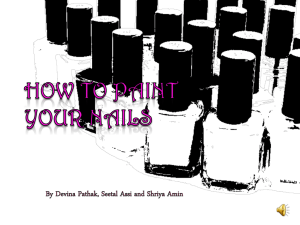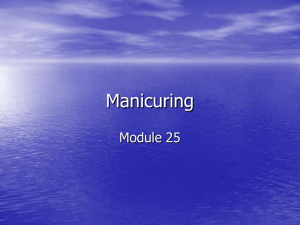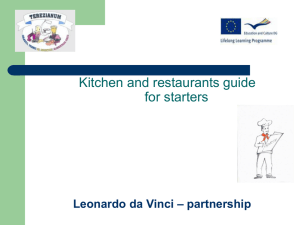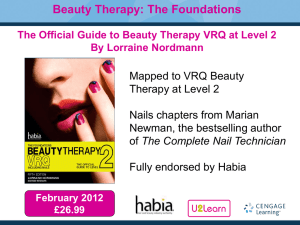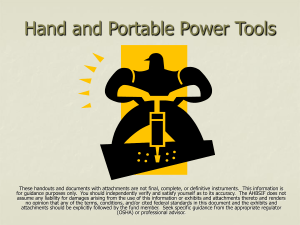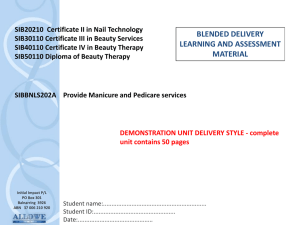manicure powerpoint
advertisement
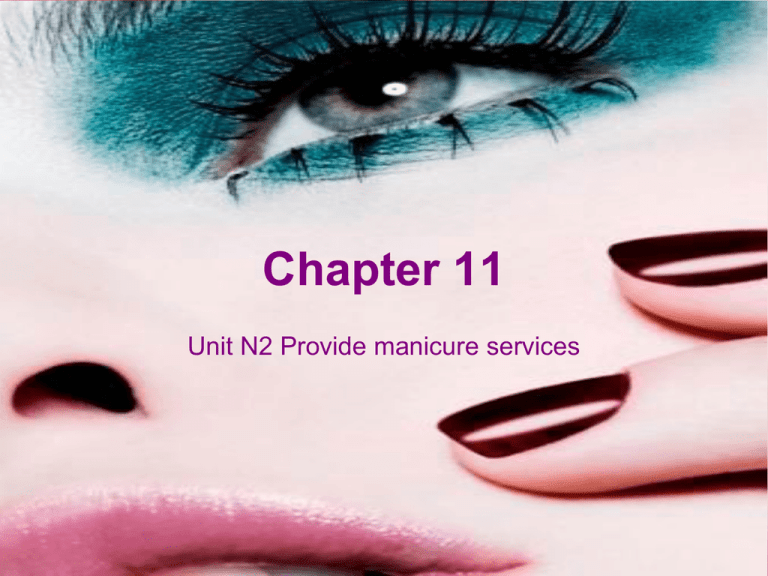
Chapter 11 Unit N2 Provide manicure services Objectives At the end of this chapter you will be able to: • maintain safe and effective methods of working when providing manicure services • consult, plan and prepare for the manicure service, demonstrating effective techniques • carry out manicure services, including paraffin wax, hand masks, thermal mitts, exfoliation and warm oil, and dark, French and buffed finishes • provide aftercare advice, including suitable tools, products, avoiding activities that may shorten lifespan of treatment, recommended homecare routines and time intervals between nail services. Key words 1 • • • • • • • • • • Acetone Agnail Arthritis Blue nails Bruised nail Buffing Callous Contra-actions Contraindications Corrugations • • • • • • • COSHH Dermatitis Disinfection Eczema Effleurage Eponychium Fragilitas unguium • French manicure Beauty Therapy Level 2 • • • • • • • • • • Hang nails Hot oil Hyperhydrosis Hyponychium Inspection Leuconychia Lunula Mantle Matrix MSDS Key words 2 • • • • • • • • • • Nail bed Nail shapes Nail wall Onycholysis Onychophagy Onychorrhexis Palpate Paraffin wax Petrissage Posture • • • • • • Psoriasis Pterygium Ringworm Sanitisation Scabies Specialised masks • Sterilisation • Warts • Whitlow Beauty Therapy Level 2 Introduction • Manicure is a popular service in beauty, hair and nail salons. Offered as part of other services. • The word ‘manicure’ is from the Latin manus (hand) and curo (care). • Purpose of manicure is to recognise common nail disorders and diseases, provide a range of treatments to improve the condition of nails and hands and offer the client advice on nail care. • Manicure includes filing and shaping nails, cuticle treatment, hand massage, nail polish application or buffing, conditioning treatment. • Ideal treatment to refer client to other services and products. Beauty Therapy Level 2 Safe working practices • Ensure that the salon environment and work area is clean and free from hazards. • There should be good lighting and ventilation. • Use appropriate seating. • Check all the equipment is clean and sterilised. • Check all the products are ready for the manicure. • Ensure that both yourself and the client are positioned comfortably. • Legal requirement for parent/guardian to be present if the client is under 16. Beauty Therapy Level 2 Treatment times Manicure with polish (including French) 40 minutes Manicure without polish (buffed) File and paint 30 minutes Specialist hand and nail treatment 60 minutes 35 minutes Beauty Therapy Level 2 Products • All products should be in closed containers and sealed appropriately. • Products include: - nail polish remover, cuticle massage cream, cuticle remover - buffing paste, hand cream, nail strengtheners, white pencil - nail polishes, base and top coat, ridge filler, polish thinner, quick-dry spray - exfoliants, masks - nail glue, nail bleach. Beauty Therapy Level 2 Equipment • All equipment should be clean. • Where appropriate, all tools should be sterilised or disposable: - nail scissors, cuticle knife, cuticle nippers, buffer, hoof stick, nail brush, orange stick, spatula, emery board - surgical spirit, jar of sanitising fluid, finger bowl, small receptacle, waste bin, thermal mitts, towels. Beauty Therapy Level 2 Consultation • Consult client to evaluate lifestyle, health, diet and objectives for treatment. • Visual and manual assessment to include palms and backs of both hands, cuticles and nails (their shape, colour and strength). • Healthy nails are firm, flexible, smooth and slightly pink. • Surrounding cuticle should be unbroken and flexible and not sticking to the nail plate. • Check each time – nail and skin condition can change between treatments. Beauty Therapy Level 2 Nail health • Nail care such as buffing and massage will increase blood supply to the nail bed. • Cells divide more quickly, so the nails grow more quickly and increase in strength. • Cells divide at matrix and harden, moving forward along grooves to form the nail. • Illness can influence nail growth. • Poor health or diet can cause nails to become dry, brittle, soft, flexible, pale, discoloured or blue in colour. • Cuticles may be dry, split and hard. Beauty Therapy Level 2 Damage to nails • Physical damage: – A knock or blow to the nail bed can cause bruising. This can grow out to the free edge. – Damage to the matrix may be temporary or permanent. Severe damage may result in loss of nail completely or a permanent ridge/split. • Chemical damage: – Strong detergents, including excessive use of nail polish remover, can cause drying of nail and cuticle. Beauty Therapy Level 2 Anatomy and physiology 1 • Nail structure includes – nail bed, nail wall, cuticle, nail fold, matrix, free edge, hyponychium, eponychium, lunula. • Bones of the shoulder girdle – clavicle, scapula, humerus and sternum. • Bones of the arm and hand – humerus, radius, ulna, carpals (triquetum, trapezium, trapezius, scaphoid, pisiform, hamate, lunate, capitate), metacarpals, phalanges. • Muscles of the arm and hand – biceps, triceps, brachia radialis, flexors, extensors, supinator, thenar eminence, hypothenar eminence, mid palm group. Beauty Therapy Level 2 Anatomy and physiology 2 • Arterial blood vessels of the arm and hand – aorta, subclavian artery, axillary artery, brachial arter, radial artery, ulnar artery, deep and superficial palmar arches. • Venous blood vessels of the arm and hand – palmar arch and plexus, radial vein, ulnar vein, median vein, brachial vein, basilic vein, cephalic vein, axillary vein, subclavian vein • Lymphatic vessels of the arm and hand – follows venous blood circulation with nodes on inside of elbow and at arm pit which are axillary. Right arm collects by right lymphatic duct, left arm collects thoracic duct. Beauty Therapy Level 2 Anatomy and physiology 3 • Types of joints – fixed (immovable, fibrous), slightly moveable (cartilaginous joints) and freely moveable (synovial joints). • Functions of bone – shape and support, protection, production of blood cells, calcium and mineral storage, muscle and tendon attachment, movement and locomotion. Beauty Therapy Level 2 Anatomy and physiology 4 • Types of muscles – voluntary (striped or striated), involuntary (smooth), cardiac muscle (heart tissue). • Ligaments and tendons – tendons are the connective tissue ends of muscles, ligaments usually stabilise joints. • Skin functions – sensation, vitamin D production, secretion, excretion, heat regulation, absorption, melanin production. Beauty Therapy Level 2 Contraindications • Contraindications restricting treatment: bruised nails, bitten nails, arthritis, open cuts and wounds. • Contraindications preventing treatment: swelling, pus or pain, ringworm (tinea), whitlow (paronychia/onychia), warts and verrucae, scabies (itch mite), severe eczema, severe psoriasis, severe dermatitis, onycholysis (nail separation). Beauty Therapy Level 2 Nail disorders • • • - These conditions are treatable. You need to know how to recognise them. They include: corrugations, split nails, brittle nails, flaky nails 'blue’ nails, white spots hard skin hyperidrosis hangnails pterygium. Beauty Therapy Level 2 Hand and cuticle treatment • Shaping nails – oval, square and pointed. • Shortening nails – filing effectively and ensuring bevelling at free edge. • Loosening adhesions on nail plate. • Removing ragged cuticles. • Conditioning nail and skin with paraffin and warm oil treatments. • Removing dead skin cells with exfoliants and masks. Beauty Therapy Level 2 Massage • Best part of the treatment. • Massage movements include: – effleurage (deep and superficial stroking) – petrissage (kneading in circular movement) – tapotement – light tapping to stimulate circulation. • Massage routine should flow easily from one movement to the other with linking movements. • Use a massage ‘medium’, such as oil, cream, lotion or talc, depending on outcome desired. Beauty Therapy Level 2 Polish 1 • Buffing smoothes the nail cells on nail plate and ‘lightly’ abrades them to create a natural shine. • If using a nail treatment or strengthener, avoid buffing as it prevents penetration of product. • Choose nail polish according to skin tone, event, age, preference, lifestyle. • Prepare with base coat or ridge filler. • Protect with after-polish sealer or top coat. Beauty Therapy Level 2 Polish 2 • Excess polish can be removed with tipped and dipped orange sticks. • Repair smudges using careful pressure with a dipped finger in nail polish remover. • French manicure – use white pencil under free edge, or paint free edge white to follow curve of natural free edge. • Male clients usually prefer shorter, square or gently rounded nails; unperfumed hand cream, deeper massage; buffed nails, or polishes that give matt finish. Beauty Therapy Level 2 Special treatments • • • • • • Stimulate blood flow. Remove dry dead skin cells. Moisturise and soften skin. Cleanse and lighten nails. Relax client. Treatments include paraffin wax, hand masks, exfoliators, warm oil. • Heat can be applied through warm towels, electrical equipment such as infra-red lamps, electric mitts, and warm oil or wax. Beauty Therapy Level 2 Contra-actions • Allergic reactions can be caused by perfumes, lanolins, formaldehyde resin, pigments, solvents used in nail polishes. • May occur around the nail itself or where the fingers touch the eyes or the skin around the face. • Serious allergy can present as redness, irritation or swelling. • Skin may become dry and scaly, blistered or infected with weeping sores. Beauty Therapy Level 2 Aftercare 1 • Always check back to record card and ensure client satisfaction during treatment. • Advise on appropriate products and tools to enhance the treatment. • Regular rebooking of client will ensure best outcome. • Maintaining good general health will enhance quality of nails. Beauty Therapy Level 2 Aftercare 2 • - Advise client to: dry hands thoroughly protect hands by wearing washing-up gloves refrain from using nails as tools buff nails massage in creams to promote circulation use nail strengthener. Beauty Therapy Level 2


